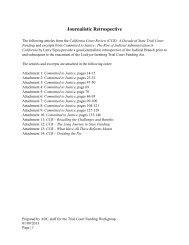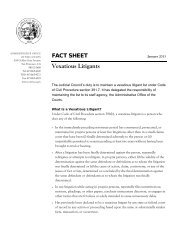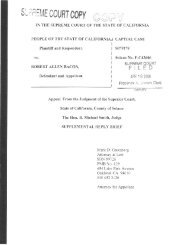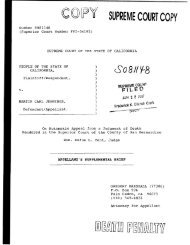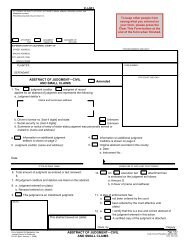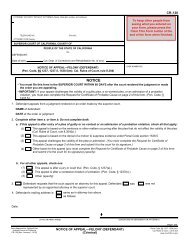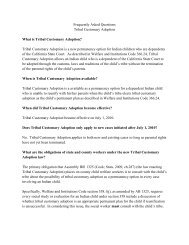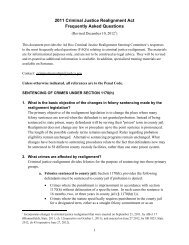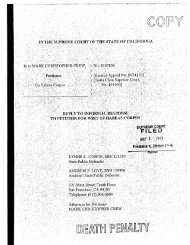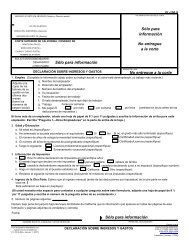Appellant, William Satele, Reply Brief - California Courts - State of ...
Appellant, William Satele, Reply Brief - California Courts - State of ...
Appellant, William Satele, Reply Brief - California Courts - State of ...
You also want an ePaper? Increase the reach of your titles
YUMPU automatically turns print PDFs into web optimized ePapers that Google loves.
<strong>Appellant</strong> has explained above and in the opening brief that his jury was<br />
instructed with a legally flawed instruction on the gang benefit enhancement. The<br />
court instructed the jury it had to find the elements <strong>of</strong> the substantive <strong>of</strong>fense <strong>of</strong><br />
gang participation instead <strong>of</strong> the elements <strong>of</strong> the gang benefit enhancement. The<br />
legal flaw was that the instruction was legally invalid for the enhancement. In<br />
Pulido, the court instructed the jury it could fmd the defendant guilty <strong>of</strong> felony<br />
murder if he formed the intent to aid and abet the underlying felony after the<br />
murder, a legally invalid theory. A legally flawed instruction is akin to instructing<br />
the jury on a legally invalid theory, such as occurred in Pulido. Just as Chapman<br />
harmless-error review was appropriate in Pulido, Neder, Roy, Pope, and Rose,<br />
supra, Chapman harmless-error review is appropriate in appellant's case. Nothing<br />
in those cases suggests that a different harmless-error analysis should govern here.<br />
(See Pulido, supra, 129 S.Ct at p. 532.)<br />
D. The Instructional Error Was Not Harmless Beyond A Reasonable Doubt<br />
Unlike errors subject to the standard <strong>of</strong>People v. Watson, supra, 46 Ca1.2d<br />
at 836, which are only reversible if it is reasonably probable that the defendant<br />
would have obtained a better result in absence <strong>of</strong> the error, instructions that omit<br />
elements <strong>of</strong> the <strong>of</strong>fense or which fail to instruct on all elements <strong>of</strong> an <strong>of</strong>fense<br />
should be tested under the standard for federal constitutional error, namely the<br />
harmless error analysis <strong>of</strong> Chapman v. <strong>California</strong> (1967) 386 U.S. 18. (Neder v.<br />
United <strong>State</strong>s (1999) 527 U.S. 1; People v, Cummings (1993) 4 Ca1.4th 1233,<br />
1313; People v. Breverman (1998) 19 Ca1.4th 142, 194" dis, opn, Kennard, J,)<br />
Chapman analysis, which is the proper standard for federal constitutional error,<br />
'vitiat[e] all the jury's fmdings.'''''' (Hedgpeth v. Pulido, supra, 129 S,Ct. at p.<br />
532 [quoting Neder v. United <strong>State</strong>s, supra, 527 U,S, at p, 11; in tum, quoting<br />
Sullivan v. Louisiana (1993) 508 U,S, 275, 281 (erroneous reasonable doubt<br />
instructions constitute structural error)],) Here, notably, the gang benefit<br />
instructional error vitiates the jury's finding on the charged personal firearm use<br />
(Pen. Code, § 12022.53, subds. (d), (e)(1». (AOB 133-134.)<br />
45



